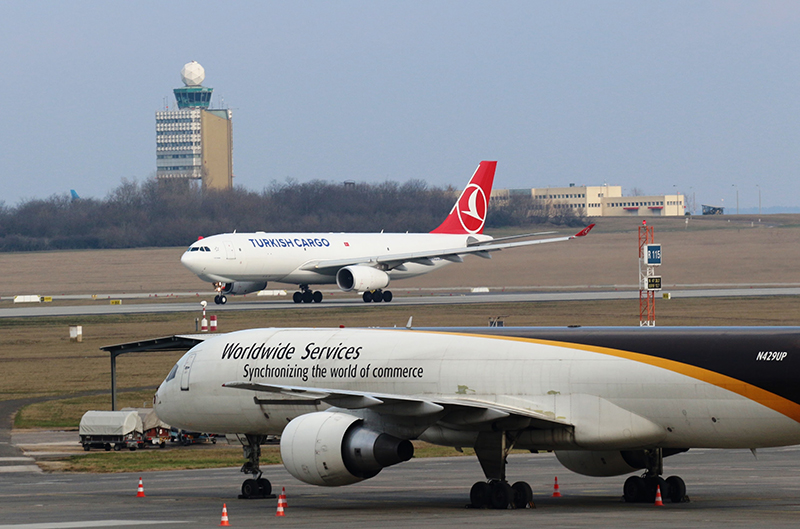
Budapest airport cargo terminal
December cargo throughput results for the world’s airport are still trickling in, but early analysis indicates an overall diminished peak season for air freight. With only a couple of exceptions in Europe and Asia, volumes and traffic across most airports posted year-over-year declines in volume for December, and declines or very modest growth overall for 2018, underperforming overall expectations of 4-5% annual growth in air freight traffic.
The uncertain global trade environment, volatile economic performance across multiple markets, and the upcoming Brexit are likely contributing to the weakness in air cargo figures during the second half of 2018.

Whether these trends will continue into 2019 remains to be seen, but considering the continued impasse in negotiations between the US and China, as well as the ongoing government shutdown in the US that it is beginning to affect aviation across the country, and Britain’s vote against a Brexit plan, we will not be surprised to see year-over-year comparisons continue to lag in the near-term.
To look more closely at December performance for some of the world’s largest cargo airports:
Asia Pacific
Hong Kong International Airport (HKG) reported its December cargo handle down 5.5% y-o-y to 448,000 tonnes. Year-to-date, HKG’s handle was up 1.5%. HKG attributed the decline in cargo traffic to global economic uncertainty with traffic to and from Europe and South Asia declining most significantly during December.
Guangzhou Baiyun International Airport (CAN) reported its December cargo handle up 3.4% y-o-y to 171,840 tonnes – comprised of 160,020 tonnes of freight, and 11,819 tonnes of mail. CAN attributed the year over year increase to growth in both inbound international and outbound cargo volumes at the airport. Inbound cargo volumes increased 2.1% y-o-y in December, supplemented by an increase of 4.5% y-o-y in outbound cargo volumes for the month. For the full year, CAN was one of the stronger performers among airports that have released December results, with a 6.5% increase in its cargo handle from 2017.

Shanghai Pudong International Airport (PVG) handled 323,000 tonnes of cargo, resulting in a 4.5% y-o-y decline in December cargo volumes. Inbound cargo volumes fell 13.6% for the month, while outbound cargo volumes fell 3.8%
South Korea-based Incheon Airport’s (ICN’s) cargo handle fell 5.2% y-o-y in December to 245,139 tonnes. From November to December, volumes declined 6.2%. For 2018 overall, ICN’s cargo handle was up 1.0% y-o-y to about 2.95 million tonnes.
Europe
Amsterdam Schiphol Airport’s (AMS’s) cargo handle fell 3.4% y-o-y in December, to 137,636 tonnes. For the full year, AMS’s cargo handle fell 2.5% to 1.72 million tonnes. AMS attributed the decline to a decrease in both inbound and outbound cargo – inbound cargo fell 4.7% y-o-y, while outbound cargo fell 2.1% y-o-y in December.
Budapest Airport (BUD) reported a 4.5 increase y-o-y in its December cargo handle, to 11,775 tonnes. Volumes at the airport were up 14.9% for the full year, compared to the same period in 2017, ultimately reaching 146,113 tonnes of cargo. The airport attributed this growth to the increasing number of wide body and jumbo freighter flights to the airport, as well as the construction of their new CargoCity freight center.
Frankfurt Airport (FRA) reported a 1.9% increase in its y-o-y cargo handle for December, to 184,000 tonnes. For the full year, FRA’s cargo handle fell 0.7% to 2.21 million tonnes.

Liège Airport (LGG) reported volumes were up 21.5% for the full year, to 870,644 tonnes, compared to the same period in 2017. LGG has not yet provided information regarding its December cargo throughput.
London’s Heathrow Airport (LHR) reported a 7.9% decrease y-o-y in its December cargo handle, to 132,000 tonnes, for the slowest traffic month at the airport since February 2017. Volumes at the airport were down 0.8% for the full year, compared to the same period in 2017.
Vienna Airport’s (VIE’s) cargo handle, including trucking, fell 4.1% y-o-y in December, to 23,484 tonnes. For the full year, VIE’s air cargo handle rose 4.4% to 215,921 tonnes.
Americas
Anchorage International Airport’s (ANC’s) cargo handle fell 2.4% y-o-y in December to 239,583 tonnes. From November to December, volumes declined 5.7%. For 2018 overall, ICN’s cargo handle was up 2.5% y-o-y to about 2.79 million tonnes.
Los Angeles International Airport (LAX) reported preliminary numbers, marking a 2.4% y-o-y increase in its cargo handle in December to 218,151 tonnes. Volumes at the airport are projected to be have been up 2.7% for the full year to 2.45 million tonnes, compared to the same period in 2017.
Ontario International Airport (ONT) handled around 75,000 tonnes of cargo, resulting in a 5.0% increase in December cargo volumes over the year prior. For 2018 overall, ONT’s cargo handle increased an impressive 14.8% y-o-y to about 750,000 tonnes.
Rickenbacker International Airport (LCK) reported volumes were up 17.6% for the whole year, bringing the airport’s total cargo handled for 2018 to almost 136,500 tonnes.
- Air Cargo Airports
.









